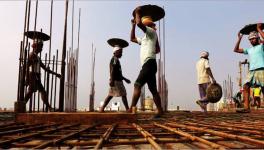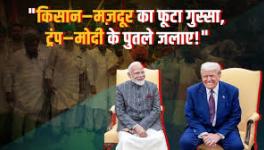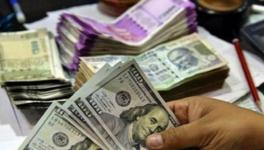RBI Hikes Floor Interest Rates Again in Desperation to Halt Rupee’s Slide
As was widely expected, the Reserve Bank of India’s (RBI) much-awaited meeting of its Monetary Policy Committee (MPC) delivered a half a percentage point increase in the floor interest rate, also termed the repo rate, on Friday morning. While ostensibly the increase is meant to signal to the markets the RBI’s stern approach to contain inflation, the reality is that this has perhaps much more to do with its desperate attempt to staunch the relentless slide of the rupee, particularly vis-a-vis the US dollar.
The latest increase implies that the floor interest rate, on which all other lending rates depend, is now set at 5.9%. The latest increase means that the base rate is now 1.9 percentage points higher than in May, when the RBI raised the rate by 0.4% at an unprecedented unscheduled meeting of the MPC. Between then and now rates were increased by half a percentage point each in June and in August. The latest move was approved by five of the six members of the MPC.
US Fed sets the rules
The RBI, like most other central banks worldwide, has been an interest rate taker ever since the US Federal Reserve adopted an aggressive unwinding of its loose monetary policy approach in the wake of the pandemic. The latest increase was by a hefty 75 basis points (a basis point is one-hundredth of a percentage point) announced recently.
Since then almost every major central bank across the world has followed suit, even if unwillingly and hesitantly, because they simply had no choice. This is because the logic of the markets dictates that currency outflows — capital flight in its more dire forms — would have resulted from these countries if they too did not hike rates to close the gap with rates set by the US Federal Reserve. Seen from this perspective, the RBI really had no choice in the matter, especially because of the severe pressure the rupee has been under in recent days and weeks.
On September 3, 2021, Indian foreign exchange reserves amounted to a little over $642 billion. By September 23, 2022, this had fallen to about $545 billion — a draw-down of $97 billion, a large part of which has been used to defend the slide of the rupee. In fact, since the end of May, forex reserves have fallen much faster — these are now $50 billion lower when compared to end-May.
In recent weeks, the rupee’s value has broken through the “psychological barrier” of Rs 80 to a dollar — whatever that may have meant — and is now within touching distance of Rs 82 to a dollar. In effect, the rupee has declined by about 8% vis-a-vis the dollar since the beginning of the year. Indeed, the chatter in the markets (read currency traders) on September 28, two days before the MPC meeting, indicated that the RBI was selling dollars at Rs 81.90 to prevent the rupee from falling further. Just five days earlier, the RBI had intervened at a price point of Rs 81.20 per dollar, indicating the speed of the slide.
Although the reserves appear sufficient to cover imports for about 15-18 months, this could be seriously misleading. Since the reserves are also required to cover for short-term debt, which is mostly owed by the private corporate sector, this can lead to sudden draw-down of reserves. The fact that about 44% of this kind of debt is uncovered for currency fluctuations means that a larger portion of the reserves are vulnerable to risks associated with the depreciation of the rupee.
The fallacious logic of devaluation
One feels for the central bank since it cannot publicly “announce” or reveal a target price for the rupee vis-vis the dollar, lest its credibility be soiled by the brute force of the market’s logic. This explains the rationale being advanced by some of its defenders, that the RBI, instead of setting a “target” should set its sights on an orderly devaluation of the rupee, whatever that may mean.
Those arguing for a devaluation of the rupee cite the familiar but discredited notions from economics textbooks (and can the International Monetary Fund be far behind?) that prescribe a devaluation as a sure-shot way of boosting exports. They also suggest that precisely because imports become costlier, this would restrain imports.
This logic is utterly oblivious to the world we are now in. First, there is a grave prognosis for the economies across the world. Indeed, there is open talk of a full-blown recession, if not a severe slowdown looming — from the US and the Eurozone to China. The ability of Indian exporters to prise open market opportunities for the narrow range of their products in such a situation is extremely limited.
Second, the Indian IT services industry, which remained relatively unscarred by the Global Financial Crisis of 2008-09, is now staring at lower revenues. This is significant because the IT industry’s dollar-denominated earnings have been provided somewhat of a buffer to the Indian state scrounging for dollars.
Third, since a large portion of Indian import bill is for crude oil, this would immediately translate into “importing” inflation.
Fourth, the growing import dependence of the Indian economy since liberalisation implies that any possibilities of an economic recovery also necessarily imply a proportionately higher share of imported inputs/raw materials and other costs. This implies that a devaluation potentially thwarts the possibility of the economy limping toward a semblance of a recovery after the worst of the pandemic.
Impact on growth
Announcing the decisions of the MPC on Friday, RBI Governor Shaktikanta Das made the customary noises about being committed to promoting growth, even when it is patently obvious that investment, particularly private investment, is not showing any signs of actual activity.
All that private industrialists have been doing is making announcements of plans and noises about how the Indian “growth story” remains intact. Indeed, the recent complaint by the frustrated Finance Minister Nirmala Sitharaman that private investment is not revealing its ‘animal spirits’, despite all that the government has done for it — massive tax sops and incentives in particular — points to this. The relentless hike in interest rates — and the uncertainty about where it may head eventually — provides a further disincentive to invest.
As India heads into the festive season, the outlook appears gloomy. Already, the RBI’s unstated defence of the rupee has meant that it has sucked out liquidity from the financial system. This is because the RBI sucks out an approximately equal value of rupees when it injects dollars into the system in order to quell the slide of the rupee against the dollar. The tightening of liquidity during the festive season, coupled with the higher interest rates, thus is a sure-shot dampener to the annual spike in demand that usually happens at this time of the year.
It is significant that the latest hike is only one in a series, with indications that the MPC meeting in December may deliver what some in the market speculate could be another hike of at least 35 basis points. Of course, all this is speculative because everything hinges on what the US Federal Reserve does with its base rate. What this implies, clearly, is that there is a significant degree of uncertainty about what the cost of finance is going to be in the near term. Investors can only move gingerly and hesitantly in such a situation.
The inflation threat
The successive increase in rates since May has already affected small-scale units’ ability to raise funds, especially for their working capital needs. Moreover, the housing market, which depends critically on long term loans by home buyers, is likely to continue to remain subdued because of the uncertainty over the interest rates. Naturally, if borrowers fear that the rates on their 25-30 year loans are likely to increase in a few months, they are likely to postpone their decisions.
Indeed, the recent RBI data on lending, triumphantly seized by acolytes of the Narendra Modi regime as evidence that all is well with the Indian economy, reveals the deep fissures. Although overall lending has increased by 14% in the last year, this is primarily because of the much higher rates of growth of consumer and retail credit. This may either be evidence of distress because borrowers have chosen to supplement lost incomes caused by job losses or lower incomes or, it may simply point to the deep divide in Indian society where a small sliver of the population has borrowed to sustain their lifestyles that have thrived during and after the pandemic. The fact of the matter is that industrial credit grew by just about 7.5%, barely enough to cover the rate of inflation.
The question of inflation remains serious. The MPC projects that inflation would reduce from 7.1% in the current quarter (ending today, September 30) to 6.5% in the following quarter and to an optimistic 5% in the last quarter of the current financial year. These projections could just as well be written on water. The prevailing uncertainty about crude oil and commodity prices (particularly metal as well as raw materials like coal) — even though they have cooled somewhat in recent weeks are likely to be significantly affected by what happens to the exchange rates. That is because the exchange rate would play an important role in determining the landed costs of these critical inputs.
Read Also: India’s Wheat Fiasco!
But, there is yet another factor, for which neither the RBI nor the Narendra Modi regime can pass on the blame to “global” factors beyond their control, and that pertains to the tightening foodgrain supply situation. A variant of the wheat fiasco is already evident with the rice crop, which will be harvested soon. The Modi government’s cynical move to “extend” the provision of 5 kg of grains to poor families till December appears to be an electoral ploy rather than any concern for food security at a time of rising food prices.
Quite apart from the weighty issues pertaining to food security, there is a serious economic question related to this. Since foodgrains are the classic wage good, a runaway increase in the price of wheat as well as rice at the same time, will have cost implications across the board for the economy. With the rice harvest also projected to decline in the current season, it would make sense for the government to establish and strengthen, in coordination with the states, the logistics of public procurement that would not just defend food security but also help in holding the price line.
Ever since the pandemic, the RBI has been used by the Modi Government as a one-trick pony. Instead of using all the levers at its command, the government has chosen to let the RBI fiddle with interest rates as the only means of promoting investment and demand in the economy. This despite the fact that even conventional economic logic dictates that monetary policy is utterly useless when demand is on the mat. The RBI’s current predicament arises fundamentally from the corner it has been painted into. The pony simply has no more tricks to deliver.
The writer is former associate editor, ‘Frontline’, and has worked for The Hindu Group for over three decades. He is a member of the People’s Commission on Public Sector and Public Services. The views are personal.
Get the latest reports & analysis with people's perspective on Protests, movements & deep analytical videos, discussions of the current affairs in your Telegram app. Subscribe to NewsClick's Telegram channel & get Real-Time updates on stories, as they get published on our website.
























